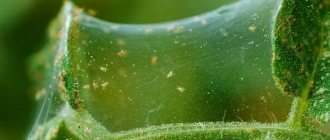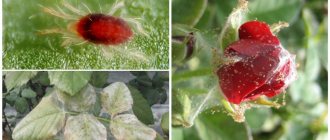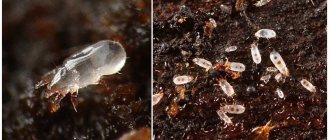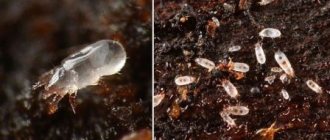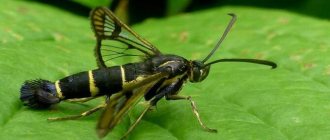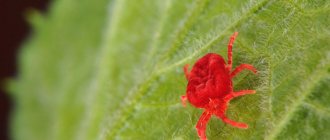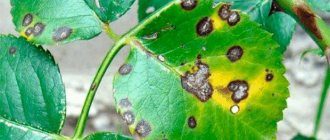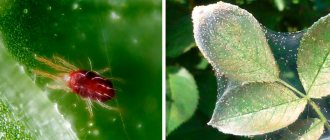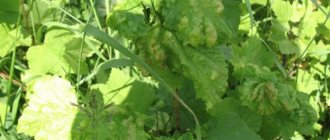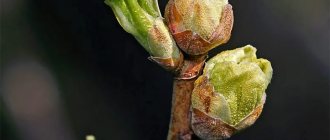There are more than a thousand species of ticks, and each one poses serious problems for human health and living organisms. Plants also belong to this category, and special types of pests settle on them.
Such a guest as a spider mite can also be found on currants. Therefore, it is worth understanding how to fight insects without hassle and quickly. There are many options and recipes, chemicals and biological methods. It is worth deciding on those that will bring effect.
Description of the pest
Of the thousand-strong horde of the family, class of arachnids, only a few damage currants. The most common is the spider mite with two spots on the back. You can also find yellow and red insects. They live and move in colonies, as this is a protective measure against predators.
The first signs of tick awakening appear with the first rays of sunlight and warming temperatures. In recent years, the time of appearance has been earlier: late February - early March.
One of the main conditions for the parasite to emerge from suspended animation is a temperature of + 2 degrees. When the mode is increased to +10, the ticks become completely established in the garden plot.
The development cycles of the pest have been determined. So the first invasion occurs from March to April. The duration of the cycle is 28 days. Then:
- 3 weeks in May, taking into account the temperature rise to + 18;
- in summer 1 week at + 25- +30;
- in September there are 21 days with a temperature of +18;
- in October 4 weeks from +12- +15.
Need to know! The tick likes to settle in warm and dry places. The generation and population of pests is constantly changing with frequent changes in weather conditions. Over the course of a season, up to 15 generations of parasites change. Therefore, the importance of preventing and treating shrubs throughout the season is especially increased.
Causes
From year to year, the number of spider mites is not the same, since their development and reproduction require certain conditions. The appearance of spider mites is due to the following reasons:
- Hot and dry weather. It is under such conditions that the mass birth of larvae occurs, which soon become adult insects. If cold snaps occur in the summer, the tick can easily wait them out.
- There is a lack of nutrients in the soil. Due to a lack of certain organic components and minerals in the soil, a general weakening of currant bushes occurs. Pests will definitely take advantage of this, since they primarily harm weakened plants.
- Infection of currants from other plants in the garden. If there is a plant infected with a mite next to a currant bush, after a short period of time the pest will move to a healthy bush.
- Dust settled on currant leaves. Heavily dusty plants are an excellent habitat for mites. In this regard, it is recommended to water currants weekly using the sprinkling method. Water will wash away dust from the sheet plates.
Signs of parasitism
Spider mites are small in size, so it will be difficult to notice the first malicious visitors. The initial stage of infection is always missed, but the second and subsequent stages can be determined quickly.
Destructive consequences of mites on currants:
- thin web;
- wilting of the green part;
- yellowing, falling leaves;
- poor bush development;
- gray cobwebby coating.
On the foliage you can see the eggs of an arachnid creature: small yellow balls, tightly adjacent to each other.
It is most likely that the display was left at the base of the plant or on the veins of the foliage. Often plant debris and weeds are chosen as a place to continue the population.
Anti-tick products
When choosing medications, you should remember that a tick is not an insect and most insecticides have no effect on it. For control it is necessary to choose acaricides or insectoacaricides.
Because spider mites reproduce very quickly, early identification is critical to further effective treatment and population reduction . The pest reproduces in April-May, when the buds bloom and young foliage appears. During this period, the pest is vulnerable to the action of acaricidal drugs.
We recommend reading how to get rid of spider mites in a greenhouse.
But keep in mind that the use of chemical pesticides actually promotes the spread of spider mites by killing the beneficial insects that prey on them. Ticks are also known to quickly develop resistance to various chemicals. For these reasons, it is important to use effective natural and organic methods.
Biological drugs
The use of natural enemies of ticks (bacteria, fungi, viruses) contained in biological products is very effective. Examples of such means include:
- "Aktoverm" is a biological insecticide for the destruction of spider mites and kidney mites.
- “Bitoxibacillin” is an intestinal bioinsecticide, does not cause habituation in ticks and works quickly, can be used in any phase of plant development.
- Phytoseiulus and Amblyseius are predatory mites for biological control of spider mites in berry crops. Packages with biopredators are hung on the bushes. After all parasites are destroyed, the predators die.
There are also biochemical preparations - “Fitoverm”, “Akarin”, “Aktofit”, “Gaupsin”. The latter remedy contains 2 strains of bacteria and is effective against a number of pests and some pathogenic diseases.
Chemicals
Chemicals to combat spider mites on currants:
- “STOP tick” is a contact action acaricide, the maximum number of applications per season when pests appear is 2, apply 3 weeks before picking berries;
- “Anti-Mite” is a bioinsecto-acaricide; after 2-3 hours the pests are deprived of the opportunity to feed and damage the plant, and after a few days they die. The product is dangerous for fish and bees and should not be used during flowering;
- “Sunmite” is an insecto-acaricide, effective at all stages of development, non-phytotoxic;
- “Envidor” is a contact acaricide, harmless to bees, resistant to precipitation due to adhesion to leaves, apply no more than 2 times per season.
The insecticidal preparations “Neoron”, “Aktara”, “Fufanon”, “Aktellik”, “Karbofos” have proven themselves well.
Folk remedies
The most accessible, cheapest and environmentally friendly ways to combat ticks are folk remedies:
- ordinary water - in the initial stage of infection, pests can be washed away from the bushes with water pressure, and constant sprinkling cleans the leaves of dust and creates high humidity in which they do not survive;
- laundry soap (50% is enough) or liquid soap for washing dishes - add ash, soda (25 g per 1 liter) or insecticides to a soapy water solution and spray the infected bushes, the soap component ensures the adhesion of the product and extends the period of protection;
- a mixture of alcohol and water in equal quantities - spray the leaves with the composition. Alcohol kills pests without harming plants;
- colloidal sulfur - inhibits the vital activity of mites and stops their spread, is effective in humid conditions, spray the bushes with dew early in the morning or after watering;
- water-oil emulsions that bind spider mites, but do not harm plants and beneficial predators - for example, rosemary oil; soap and kaolin are used as an emulsifier;
- infusions of herbs - wormwood, onion peel, tobacco, garlic, dandelion, yarrow, marigold, nightshade tops, celandine. Herbs in various combinations are crushed and left for a day before spraying.
Effective means to combat spider mites
The fight against spider mites on currants involves complex measures: a combination of 2 or more chemical, biological and folk preparations.
It is important to consider the growing season before processing the bush. Thus, during fruiting and flowering it is not recommended to treat with chemicals. But biological substances and folk recipes will definitely help.
Chemicals
Acaricides and insecticides with a chemical composition are also sufficient. Application is recommended in spring and after harvest. Will help:
- Envidor;
- Sunmite;
- AntiMite;
- Stop-Tick.
Plants that can help get rid of pests
Decoctions and infusions of some fresh or dried herbs work as acaricidal preparations, but they have a weakly expressed property. In addition, those active substances that fight pests are not very persistent. Because of this, it is most effective to treat the plant in the evening or in the morning - at this time there is no strong solar activity.
- Plants such as wormwood, dandelion, datura, calendula, celandine and yarrow will help in the fight. In addition, garlic and onions are effective - they need to be crushed into a paste, diluted with water, allowed to brew for a day, after which this can destroy most of the pests.
- There is a way to fight it using potato tops, from which you need to make an infusion. They will need to spray the bushes every 3 days because the eggs tolerate this liquid well, which is why new generations need to be treated.
Terms and schemes for processing currants
If we talk about preventive treatments, it is worth remembering that spraying is carried out taking into account the growing season and tick invasion cycles.
For therapy, a remedy is also selected that will not harm the growth and development of the bush.
Before the currant blossoms
Ticks emerge from the suspended animation stage early, so infection of a currant bush can occur as early as March-April. Hence the need to fight with all available means arises.
The most common option is chemicals. The main condition: carry out the work before the ovaries appear. Validity periods reach up to 21 days.
During the fruiting period
At this stage of shrub development, it is not recommended to spray with chemicals. They use biological agents and natural enemies of ticks.
As a supplement for effectiveness, folk solutions are made. Do not forget to manually process currants to prevent the appearance of a new brood.
Consequences of defeat
Spider mites lead to a general weakening of the plant. If you do not destroy it before the ovary appears, then you can’t expect to get a harvest at all this year. It feeds with equal appetite on both the ovaries and the leaves, sucking the juice of the plant.
This pest is also dangerous because it is a carrier of a number of dangerous viral diseases. And viral diseases, as we know, cannot be cured. Bushes infected with viruses must be uprooted and burned.
Bushes weakened as a result of tick parasitism cannot always overwinter successfully and often simply freeze out.
Flower buds do not form on weakened plants, therefore, there is no need to expect a harvest next year.
With significant damage to currants by mites, secondary damage to the plants by powdery mildew occurs. It is very difficult to fight two diseases at the same time.
Prevention and protection of the garden
The mite prefers to settle on white and red currants. But the black species also suffers from attack.
It will be easier to prevent the spread of the pest, as well as quickly neutralize the threat at the first obvious signs, if:
- regularly remove weeds from the area;
- set traps under currant bushes;
- carry out sanitary pruning;
- water the plant using the sprinkling method;
- during the awakening of the culture, use the boiling water treatment method;
- monitor the looseness of the soil under the currants.
Preventive methods of working with shrubs help not only prevent infection by ticks, but also other parasitic insects, the lion's share of infections, and fungal diseases.
Why is mite dangerous for currants?
When the mite population is high, the leaves become marbled, and over time they become brown and dry out. At first, the photosynthetic surface of the leaf is reduced and thereby the physiological balance is disrupted, then the currant loses leaves and shoots, the yield decreases and the winter hardiness of the plant deteriorates.
Ticks that feed on juice can be carriers of viral and bacterial diseases of currants. In addition, the web worsens the aesthetic appearance of the bush.
Follow preventive measures
- Remove weeds from the soil . From them, mites often fall onto currants, so the soil must be clean. It is also very important to remove all plant debris in the autumn, since most tick larvae overwinter in them.
- Thin out plants and trim branches . Avoid thickening the bushes; when they are well ventilated, they are less affected by ticks. It is important that all diseased shoots are removed.
- Maintain normal humidity . If the air is very dry, pests multiply much faster.
- Scald currants with hot water in early spring . This simple manipulation kills spores of many diseases and pest eggs.
Scale of harm caused
Both bud mites and spider mites can lead to crop loss, and if not controlled, cause the death of blackcurrant plantings . Despite their small size, these pests cause enormous damage to plants due to their numbers. In addition, bushes weakened by their activity become a target for various diseases and other pests.
In early April, female bud mites begin to actively lay eggs (up to 8,000 from one female), which “mature” within 6-12 days. After this time, young individuals of the bud mite emerge and rush to healthy parts of the plants, climbing inside the yet unopened buds. They feed on plant sap, leading to the drying out of still unexpanded leaves, inflorescences and young shoots. In one year, the kidney mite produces at least 5 generations of offspring.
However, the main danger is not only the depletion of the plant. Even if you take timely measures to combat the pest, the bush may suffer from the terry virus, which can only be gotten rid of by completely destroying the plant.
Spider mites are a pest that causes weakening of the plant. Its activity leads to a deterioration in winter hardiness, which is why black currants can freeze even in a warm winter with a large snow cover. There is no need to talk about productivity at all, since without a supply of certain substances obtained during the process of photosynthesis, flower buds on this crop are not formed.
The use of chemicals and other drugs to destroy the currant bud mite
The following methods for exterminating currant bud mites are not safe for the owner, his family, pets and birds. Therefore, before starting to use pesticides to kill ticks, it is necessary to carefully prepare, study the action and aftereffects of the chemical, its effectiveness, repeated use and technical recommendations in the specialized literature.
Frequency of treatments
If the instructions for use of the drug are violated, its effectiveness can be reduced to zero.
The development cycle of the currant bud mite depends on external temperatures. The first active development of currant bud mite larvae begins at an air temperature of +10..+12 °C, but their emergence and migration may occur after 25 days, until the air warms up to +18 °C. The higher the air temperature rises, the shorter the period of development from the egg of a carnivorous larva, which will infect new buds on the native and neighboring bushes (Table 1).
Table 1. Treatment intervals with drugs against currant bud mite
| Air temperature, °C | Development period, days | Treatment interval, days |
| +12..+18 | 25-30 | 8-12 |
| +20 | 20 | 10 |
| +25 | 10 | 5 |
| +30 | 6 | 3 |
The number of treatments in the temperature range must be at least three:
- the first treatment destroys overwintered adult female currant bud mites and hatched larvae (cold-resistant). Some eggs do not have time to go through the development cycle;
- with the onset of warmth, the second wave of larvae completes the development cycle. If you do not maintain the treatment interval (if you are late in treating the bushes), the larvae have time to turn into adult ticks and lay a second clutch of eggs.
- the third treatment is safety. The surviving young females of the currant bud mite can lay eggs, which will give rise to a new outbreak of infection of the bushes.
It is especially important to record the first migration of currant bud mite larvae. During this period they are visible to the naked eye. After treating the bushes, monitor the temperature in the future and observe the treatment interval. For example: the temperature is maintained in the range of +20..25 °C – the treatment interval is 8-10 days.
Currant buds affected by currant bud mite. © Christina
How to deal with bud mite on currants (video)
Signs of kidney mite activity
As its name suggests, the currant bud mite only affects the buds of the plant. It is by their appearance that the presence of a pest on plantings can be detected. When the snow melts, unusually large buds, sometimes severely deformed, are clearly visible on infected plants. The fact is that sexually mature female ticks overwinter in them, ready to reproduce with the onset of the first fine days.
The condition of the plantings and, accordingly, the future harvest depend on the time of detection of spider and bud mites on black currants. That is why it is recommended to annually inspect the branches for the presence of swollen buds and remove them before the first generation of mites emerges. During summer infection, signs of damage by bud mites include changes in the shape, color and structure of the apical leaf blades. They become leathery, slightly deformed and lighten.
Signs of spider mites
It’s not for nothing that the spider mite is called the scourge of gardens, because this pest can handle more than 200 crops, which it feeds on throughout the summer. Only the female pests survive the winter, hiding under fallen leaves. In the spring, they climb onto plants and lay thousands of translucent eggs on young leaves. A week later, larvae emerge from them, entangle the leaf blade with a web and feed on its juices.
You can notice the activity of spider mites by carefully examining black currants. First, light microscopic dots appear on the leaves of (single) bushes, which later completely cover them. Gradually, such marbling transfers to neighboring leaf blades. Sometimes the finest cobwebs can be found on berry bunches.
Preventive measures
Prevention measures aimed at creating conditions unfavorable for ticks will become more effective and less costly.
To do this you need to follow some simple steps:
- from time to time destroy weeds on the site;
- collection and disposal of fallen leaves;
- use healthy planting material for propagation;
- increase the immunity of currants by applying fertilizers;
- digging up the soil around the bushes.
Start fighting ticks immediately after detecting traces of their presence. Delay and indecisiveness will lead to massive damage to bushes and loss of crops. Act methodically and consistently. By applying our recommendations, you can keep your currants healthy, even if ticks are rampant at your neighbors’ dacha.
Mite-resistant varieties
Unfortunately, at the moment there is no currant variety that is resistant to attack by all types of mites, including bud mites and spider mites. The second, by the way, does not hesitate to destroy the strongest plants that are immune to diseases and pests.
Only some varieties of black currant are resistant to the bud mite:
| Variety name | Description of the variety | Level of resistance to kidney mite |
| Early Potapenko | Early fruiting variety with large sweet berries. Compact, medium height. Disadvantage – early aging | High |
| Otradnaya | A vigorous plant with large berries. Advantages of the variety: high winter, drought and heat resistance | Above average |
| Vigorous | Tall, sparsely leafy bush, the fruits are large, plum-shaped, sweet and dense | High |
| Nara | Medium-sized bush with spreading curved branches. The berries are very large and sweet, ripen early | High |
| Kipiana | A fast-growing, self-fertile early variety with large berries and a medium-sized spreading bush | High |
In addition to the listed varieties, black currants “Nightingale Night”, “Belorusskaya Rannyaya” and “Shalunya” are relatively resistant to bud mite. The bud mite affects red currants as often as black currants. Currently, breeders have developed several varieties resistant to this pest.
| Variety name | a brief description of | Degree of stability |
| Earring | A winter-hardy tall variety with a spreading branched crown and small berries with a sweet and sour taste. | Above average |
| Early sweet | Medium-sized bush with a compact semi-spreading crown. The berries are small, very tasty | High |
| Dutch early | An early ripening variety with a spreading, medium-sized crown. The berries are large, with noticeable sourness | High |
| Memory of Gubenko | A high-yielding small-fruited variety with a spreading, medium-sized crown. The taste of the berries is excellent | Very high |
| Transdanubia | Large-fruited variety with medium vigor. Spreading bush, compact, medium leafy | High |
What threat does it pose to the plant and the crop?
If measures are not taken in time and harmful insects are not dealt with, there is a risk of complete loss of the crop. Mites provoke a decrease in yield, lead to the destruction of ovaries and damage the leaves.
If the plants are not treated immediately, the risk of infectious pathologies increases significantly. Even disease-resistant currant varieties encounter viruses. The presence of pests also increases the risk of powdery mildew.
The use of biological products against currant bud mite
Bioacaricides can serve as such means. They are developed based on positive strains of fungi and bacteria and are harmless to humans. Along with a large list of positive properties of bioacaricides and bioinsectoacaricides, there are also limitations in their use. The main thing is that the drug works effectively at elevated temperatures (+15..+19 ºС). In windy, cold weather, which often happens in early spring, they are useless. If spring is early and has high temperatures, the use of acaricidal drugs is highly effective.
The best known bioacaricides are:
- bicol;
- Boverine;
- bitoxybacillin;
- phytofarms;
- acarin.
The preparations are used at intervals depending on the ambient temperature, until the end of flowering and after harvesting. Drugs must be alternated. They are well compatible in tank mixtures with biofungicides. However, before preparing a tank mixture, it is necessary to check the compatibility of drugs, especially new ones. Dilution and processing methods are indicated on the packaging. Do not deviate from the recommendations; independence will not bring success.
Currant buds on a bush affected by currant bud mite. © Ötökkätieto
How to prevent currant mites from infecting shrubs?
This is a dangerous parasite, and in order not to have to fight it, using such potent drugs as “Kleschevit”, “Aktellik”, “Bi-58” and others, it is necessary to take measures to prevent its appearance on the plot:
- use varieties that are resistant to pests (“Shalunya”, “Riddle”, “Sevchanka”, “Nightingale Night”, “Pamyat Michurin”, etc.);
- take into account the soil type when planting;
- carry out crop rotation at regular intervals;
- reject suspicious planting material;
- carry out spring and autumn sanitary pruning;
- disinfect seedlings and cuttings before planting;
- inspect bushes during pruning to identify pests;
- treat bushes with signs of disease, preventing the spread of parasites to neighboring plantings;
- keep the area clean, promptly remove fallen leaves and carrion from it, as well as remove weeds.
Application of chemicals
You can use chemicals before flowering, or at least during it. During fruiting, chemicals are absorbed into the fruit, causing poisoning in humans. Treatment during fruiting is justified only if the bush is severely damaged; the berries cannot be eaten.
It is noteworthy that acaricidal agents act only on adult ticks and larvae, without harming the eggs. Therefore, the bush is treated with chemicals in several stages in order to destroy all generations of the pest.
Such drugs as Sunmite, Oberon, Nissoran and Envidor have proven themselves well. It is recommended to use the drugs alternately so that the parasite does not develop an addiction to them.
Agrotechnical measures
Timely watering, fertilizing and treating plants, which will increase the plants’ immunity to the damaging effects of pests.
For planting and propagation, use only zoned, pest-resistant varieties.
It is very important that the planting material is not affected by the pest. To prevent infection, you can completely immerse a seedling or rooted cutting for 18-20 hours in a working solution prepared from agrovertin (10 g) and colloidal sulfur (40 g) in 10 liters of water.
Before planting, seedlings and rooted shoots can be kept in hot water (+40..+45 °C no more) for 15 minutes;
The larvae of currant bud mites cannot tolerate high air humidity. You can take advantage of this property and, during the first migration of hatched larvae (the first spring generation), drain the berry garden.
Every year, in early spring (early March), treat the dormant buds of black, red and white currant bushes (currants only) with fire.
Carrying out the procedure: After sanitary and thinning pruning of the currant bushes, use a blowtorch or gas burner at a distance of 8-10 cm to run along the branches 2-3 times from top to bottom, without stopping, so as not to burn the branches. Heating by fire will kill aphids and most bud mites without damaging the plant. Fire will not damage healthy buds covered with dense upper scales. Diseased buds are loose, the cover is torn by overpopulation of the bud by pests that lay eggs of future offspring. They are very vulnerable during this period and the fire (high temperature) burns and causes the death of unwanted “tenants”. Of course, not all females die with this method, but their activity decreases sharply.
During the same period, instead of fire treatment, you can “bathe” the currant bushes with a hot shower, spending 1.0-1.2 buckets of water on a large bush.
Carrying out the procedure: To process the bushes, it is more convenient to use a watering can with a sprinkler. Pour boiling water into a container. Above the bush, from a height of approximately 15-20 cm, we wash the bush. At low air temperatures, hot boiling water, when filling the waterer and until the water reaches the bush, will cool to +60..+70 °C. This temperature will not damage the plant, but will destroy some pests (the principle of action is the same as during fire treatment) and fungal infections.
Save the environment!
The oldest method of exterminating pests was invented by nature itself. Each pest has natural enemies in nature, entomophages, which effectively reduce the number of pests of plant crops. Be attentive to the small workers of gardens and berry fields. When using chemicals, remember that you are also destroying beneficial fauna.
Ticks are effectively destroyed by beneficial insects:
- ladybug (stetorus);
- carnivorous bug;
- carnivorous mite;
- lacewing;
- chalcids (riding insects);
- Phytoseiulus;
- encarzia
- hoverfly and others.
More information about herbivorous mites can be found in the article “Mites are herbivorous garden pests.”
Dear readers! You have become familiar with the main methods of exterminating the currant bud mite, which causes significant damage to berry crops. Not all methods are harmless to humans, animals, and beneficial insects. Before using any of the drugs suggested in the article or purchased, carefully read its effects and decide whether its use is suitable for you. The choice is yours. Offer us your ways to protect berry plants from this and other pests in the comments to this material.
Biological enemies against spider mites
To save berries from spider pests, you can resort to their natural enemies. These are predatory mites that feed on their fellow mites - Amblyseius and Phytoseiulus , which are sold both on the Internet and in gardening and floriculture stores.
This remedy is the simplest in terms of effort and quite expensive in terms of finances - the packaging of the mites is designed for an average indoor plant, so for a currant bush you will need several of them.
But you can forget about the hassle of destroying ticks - now predatory relatives will happily take on this task until they exterminate all the spider “brethren”.
